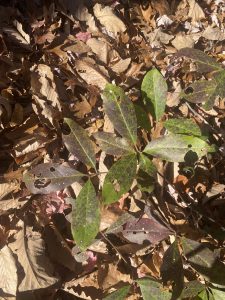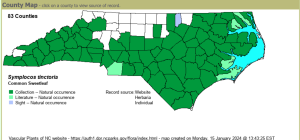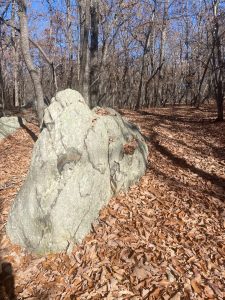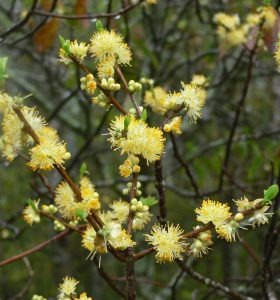On a sunny and pleasant November Sunday, my husband, Peif, and I decided to explore someplace new. We wanted to walk on forested trails, to bring our dog Luna, and to not venture too far from home. From the three possible destinations I offered, Peif chose to explore Purgatory Mountain in Randolph County. We’ll save Caraway Creek Preserve and birding hotspot Guilford County Farm for other weekend rambles in the coming months.
Purgatory Mountain is in Randolph County and is managed by and adjacent to the North Carolina Zoo. The trailhead for Purgatory Mountain is at the north end of the parking area for the “North America” section of the Zoo. To hike the trails one does not need to pay admission to the Zoo.
How did Purgatory Mountain get its name? “Although the Uwharries are some of the oldest mountains in the world, Purgatory Mountain did not get its name until at least the Civil War. Some believe the mountain was named by war objectors hiding out there, while others attribute the moniker to the abundance of small fires dotting the hillside during bootlegging operations,” says Betsy Roznik, Associate Curator of Regional Conservation with the North Carolina Zoo.1
Why did I target Purgatory Mountain for a visit? I’d first heard about it from University of North Carolina at Chapel Hill Herbarium lichen curator Gary Perlmutter. He and fellow lichenologist Eimy Rivas Plata documented 24 species (plus one organism identified just to genus) of lichens on Purgatory Mountain in 2011. Gary and Eimy deposited vouchers for all these in the UNC-Chapel Hill Herbarium so other scientists can examine them. Gary and Eimy presented the results of their surveys of Purgatory Mountain and nearby Ridges Mountain (also managed by the NC Zoo) at the Seventh International Lichenological Symposium – IAL7 in Bangkok, Thailand, in 2012.
In June, 2009 the Carolina Vegetation Survey (CVS) team led by Dr. Robert Peet at University of North Carolina at Chapel Hill made a thorough inventory of the vascular plants growing in a temporarily flooded upland pool on the saddle between Purgatory Mountain and Middle Mountain. CVS teams returned to Purgatory Mountain in May of 2013 to survey the vascular plants of the Piedmont Monadnock Forests. Other botanists who have explored Purgatory Mountain include Pete Diamond and Nell Allen, botanists on the Zoo staff, and Bruce Sorrie with the North Carolina Natural Heritage Program.

As Peif and I strolled around Purgatory in late November, our botanizing was limited to “evergreen” or “winter green” plants such as Striped Wintergreen (Chimaphila maculata), Fan Clubmoss (Diphasiastrum digitatum), mosses, and lichens. At one point on Purgatory Mountain, due to the deep carpet of oak, sourwood, and red maple leaves obscuring the path, we found ourselves off-trail. We decided to hike cross-country, down into a ravine. This was a fortuitous route, as we came across a small stream where Luna could take a long drink. On the steep-ish slope up to Middle Mountain, Peif found a shrub which was clearly different from the abundant Mountain Laurel (Kalmia latifolia L.) which we’d encountered on the Purgartory Mountain side of the draw. iNaturalist and I came up with the identification simultaneously: Horse-sugar or Sweetleaf ( Symplocos tinctoria (L.) L’Heretier). It’s not a shrub I see very often and I do not have a good “feel” for where to find it. The leaves, particularly those that are still present in the fall, have a characteristic blackish tint — likely due to a fungus. I tasted a leaf, and while it was not particularly sweet, it was pleasant-tasting, another characteristic of Symplocos tinctoria. “As the name implies, the leaves are somewhat sweet (especially near the midvein), but the sweetness seems variable from plant to plant, season to season, and taster to taster,” according to Alan Weakley’s Flora of the Southeastern United States.2
According to Bruce Sorrie and Harry LeGrand, “The habitats of this species are widespread but difficult to categorize. It favors damp yet sandy soils. But, it is found along pocosin margins, steamhead pocosins, some bottomland forests, a variety of mesic forests, and even on bluffs and ridges! It is widespread in sandhills forests, though normally not in deep sands. For example, at Hemlock Bluffs in Wake County, it grows on steep bluffs “in place of” Mountain Laurel (Kalmia latifolia), which is surprisingly absent there! It tends to favor pine-dominated sites and is scarce under a hardwood canopy.” 3 In fact, the last time Peif and I had encountered (and were puzzled by!) Horse-sugar had been at Hemlock Bluffs Nature Preserve in February 2023.

I’ll have to keep Horse-sugar on my botanical radar, as it has been documented in Orange County from the area around Hollow Rock (known as “The Caves”) and from around University Lake/ Price’s Creek in the 1930s, but not since. I’ll also keep an eye out for it in Alamance County, as it has yet to be documented from there.
Besides reacquainting myself with Horse-sugar on Purgatory Mountain, I greatly enjoyed the rocks of the monadnock. The grey rocks looked like subterranean cetaceans surfacing from the forest depths. Many of the rocks were thin, and running in parallel formation, adding to the illusion of cetacean pods. Next time I stroll around Purgatory, I’d like to do it in the company of a geologist so she can tell me more about these felsic volcaniclastic rocks.

Occurrences of Horse-sugar (Symplocos tinctoria) documented in Orange County, North Carolina4:
NCU Accession # 68434, collected by Ross, NC: Orange Co.: Chapel Hill, April 1897
NCU Accession # 68436, collected by J.S. Murphy, NC: Orange Co.: Chapel Hill, 21 April 1897
NCU accession # 68419, collected by H. R. Totten, identified by William Chambers Coker, NC: Orange Co.: “Caves” in clump of Rhododendron, on New Hope Creek, above Patterson’s Mill, 2 May 1915
NCU Accession # 68421, # 68424, # 68425, collected by William Chambers Coker, NC: Orange Co.: New Hope Creek, at the Caves, 25 July 1915
NCU Accession # 68417, collected by Budd Elmon Smith, NC: Orange Co.: around Uni. Lake [sic; University Lake], Chapel Hill, 20 May 1932
NCU Accession # 3184, collected by Addie W. Totten, NC: Orange Co.: New Hope Creek low grounds about 2 mi below Chapel Hill – Raleigh Road, 18 March 1935 [this location may be in Durham County]
NCU Accession # 68416, collected by William Chambers Coker, NC: Orange Co.: Main branch of Price’s Creek, about 0.33 mi above Mr. Daniel’s pasture, 18 October 1936

SOURCES:
1. Roznick, Betsy. 2021. Spend some time in Purgatory: Exploring the Zoo’s Purgatory Mountain. https://www.nczoo.org/blog/spend-some-time-purgatory-exploring-zoos-purgatory-mountain accessed on 19 Nov 2023.
2. Weakley, A.S., and Southeastern Flora Team. 2024. Flora of the southeastern United States Web App. University of North Carolina Herbarium, North Carolina Botanical Garden, Chapel Hill, U.S.A. fsus.ncbg.unc.edu Accessed Jan 15, 2024.
3. LeGrand, H., B. Sorrie, and T. Howard. 2024. Vascular Plants of North Carolina [Inernet]. Raleigh (NC): North Carolina Biodiversity Project and North Carolina State Parks. Available from https://auth1.dpr.ncparks.gov/flora/index.php
4. SERNEC Data Portal. 2024. http//:sernecportal.org/index.php. Accessed on January 15.